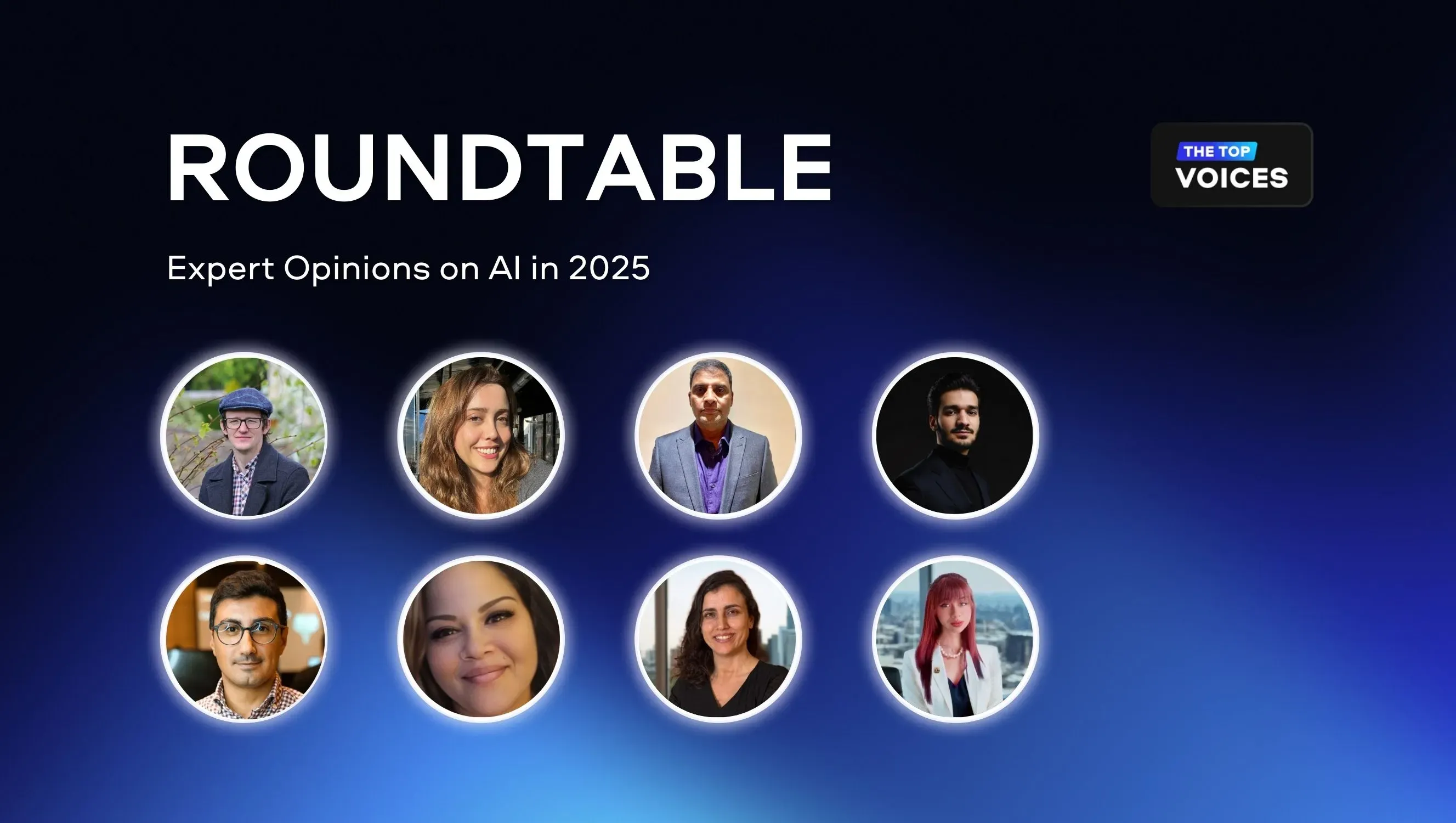AI is transforming industries at an unprecedented pace, redefining how businesses innovate and compete in 2025. To better understand where the field is headed, we are hosting a roundtable discussion with leading experts in artificial intelligence. In this session, professionals will share their perspectives on the latest breakthroughs, the most promising applications for startups, and the ethical and regulatory challenges that come with rapid adoption. Founders will gain actionable insights into how to leverage AI effectively in their ventures and prepare for the opportunities and disruptions shaping the AI landscape in 2025.
Our experts:
- Alexander Vakhitov, Head of Computer Vision and AI
- Ceren Yurtlu, AI and Data Enthusiast
- Imtiaz Shaik, Senior QA Analyst
- Kenan Shahrour, Senior AI Engineer
- Rami Sarieddine, Senior Solution Engineering Manager
- Shellie Price, Customer Service
- Sonya Trivedi, Founder at AIMAR
- Taiefa Tabassum, Marketing Assistant
Alexander Vakhitov, Head of Computer Vision and AI

What AI-driven trends do you see shaping your industry, and how are they already influencing decisions and strategies?
Large language models (LLMs) and generalist vision-language models (VLMs) are revolutionising whole technological domains, and robotics and automation is not an exception. While large and powerful language and multi-modal neural networks had been used by large technological companies already some years ago, nowadays small robotics startups and R&D teams can leverage those models with ease. Robotics remains a domain where new methods and technologies are easily adopted as building blocks used to build large and complex autonomous systems.
Roboticists are concerned with real-time machine learning models able to run on edge devices. While neither LLMs nor VLMs are designed for edge devices, they certainly can be used in building and improving those edge device models. VLMs such as commercially available SAM and SAM2 from Meta can simplify and speed up data annotation efforts, providing high-quality reference for object detection, segmentation, scene understanding and other vision-based tasks. At Slamcore, we leverage powerful VLMs for benchmarking our real-time models, gaining insights by comparing the outputs of VLMs and edge ML models and emphasising failure cases in our training.
While usually edge devices cannot run large networks due to hardware and latency limitations, they can interact with powerful models deployed in the cloud. For example, when exploring a new area, an autonomous robot can have a limited set of objects detected at the edge to solve real-time navigation and other low-latency tasks, while large cloud-deployed models would be applied for a deeper understanding of environments or situations with higher latencies. At Slamcore, we envision large cloud-deployed models analysing videos and scenes and providing high-level analytics information for humans supervising industrial operations.
If we speak about LLMs, their ability to generate relatively reliable software code enables the creation of advanced applications with modern user interfaces by relatively small teams. These teams leveraging AI tools are able to create products for the end customers while still staying deeply focused on their core technology development. It facilitates innovation and reduces the costs of pushing new technologies to revolutionise established industries.
Moreover, typical industrial and robotics systems generate large amounts of data. Slamcore’s Real Time Location System reports locations of industrial vehicles as well as pedestrians in arbitrary environments 24/7. Agentic workflows created on top of LLMs facilitate the retrieval and analysis of data, enabling sophisticated question-answering and data visualisation for non-technical users who can interact with our tools in natural language. At the business level, conversational agents with access to data collected from industrial facilities can provide insights into improving operational efficiency. These tools enable direct interaction of business-focused managers with data, facilitating innovation and optimisation of business processes inside companies. At Slamcore, we see great potential benefits in using AI tools for providing data analysis services for our end customers.
What’s something AI still completely fails at in your domain?
Modern vision and language models successfully demonstrate their generalist behaviours, solving a wide variety of tasks on par with specialised models. However, this is mainly about large cloud-based models and services. Real-time reasoning, not speaking about learning to solve new tasks autonomously and directly on the edge device, is something we do not see as coming any time soon at the moment. Only this type of technology could enable truly autonomous and universally applicable robots. At Slamcore, we mitigate this limitation by finding reasonable tradeoffs between developing small specialised models for edge devices that can interact with large, higher-latency models deployed in the cloud.
What AI trends do you believe will most disrupt your industry in the next 2–3 years, and how are you preparing for them now?
There is great potential for improving the way computer vision and vision-language models are learned. We curate datasets, investing money and effort into manual data annotation. AI tools can facilitate and automate this process, bringing in flexibility and options to customise models and robots to fit the needs of a particular customer. Instead of predefined robots for massive use-cases, we are going to see a variety of customised robots on top of universal platforms, each working on a slightly different task.
Ceren Yurtlu, AI and Data Enthusiast

What AI-driven trends do you see shaping your industry, and how are they already influencing decisions and strategies?
AI is turning the web into an “answer layer” — people ask the model first instead of talking to people or visiting different sites. That makes life fast (thanks), but it also shrinks the diversity of voices online and risks a loop where AI learns from AI. More subtle: people start to look for validation from models — not opinions from other humans. The tricky part for us: we must design AI that boosts creativity and real communities, not makes everyone dependent on a single feed of canned answers.
What’s something AI still completely fails at in your domain?
It still can’t think like a human. Models stitch probable words together — they don’t really understand nuance, emotion or messy, culturally coded CVs. In long, personal conversations they lose track and hallucinate. You can feel the difference: humans read intent, irony, context — AI often flattens that into a bland summary. That gap is exactly why we need human-centered data and product design.
What AI trends do you believe will most disrupt your industry in the next 2–3 years, and how are you preparing for them now?
Autonomous agents and AI-driven skills verification. Agents will not just answer — they’ll act: summarize your Messenger/WhatsApp threads, draft and negotiate small deals, even hunt and apply for jobs. Hiring will shift to live, AI-scored project sims instead of paper CVs. I’m prototyping small agent flows (LangChain/Gemini experiments) and building with ethics first: transparency, user control, and ways to keep humans in the loop.
Imtiaz Shaik, Senior QA Analyst

What AI-driven trends do you see shaping your industry, and how are they already influencing decisions and strategies?
In the software development life cycle and specific to QA industry, AI is transforming the way we approach and troubleshoot software quality problems. AI is now being used to automatically create test cases by analyzing the criteria and user stories. This will help the team save time and ensure broader test coverage. AI is also being implemented to identify defect trend data from the past releases which predict the riskiest parts of the system function before next release into production.
AI-driven logs are another tool used to help QA team members to detect any issues from reactive bug-finding to proactive quality assurance. Outcomes of testing resources are more strategic, faster and carry enhanced releases. Integrating AI-assisted testing into CI/CD pipelines helps give a more control decision. The QA field is advancing into a position of quality enabler by following standard protocol, certifying, and enhancing AI outputs to validate the software meets the user's expectations.
What’s something AI still completely fails at in your domain?
One of the issues AI encounters is with familiarizing operational business demands in applications. Although AI can produce numerous quality checks using UI, it will be unable to evaluate the users test scenarios or which operations are business critical. AI still struggles to manage complex compliance rules like union agreements, benefit structures, specific country tax calculations and legislative updates. While AI is capable of processing test data, performance metrics, software build metrics and test execution reports efficiently, without human supervision it still has difficulty to validate financial and legal regulation. Another way AI still completely fails is employee bonuses, overtime hours calculation, which demand awareness of business guidelines that have difficulty managing it. Quality assurance positions perform important tasks authenticating accurate calculations and maintaining compliance prior to launch of product.
What AI trends do you believe will most disrupt your industry in the next 2–3 years, and how are you preparing for them now?
The AI trends in software testing will disrupt QA roles in the next 2-3 years by natural language test automation. This test helps produce test scenarios and it is conducted straight from plain English instructions. Doing so will help reduce the barrier to automation and help move QA positions from scripting to oversight and certifying AI outcomes.
For a QA member to be equipped they need to understand how to verify AI results, merging AI resources into CI/CD pipelines, and help transform QA positions into quality specialists instead of a manual tester. This shift will not replace testers with AI but instead will help testers to direct AI for more reliability, faster and smarter.
Kenan Shahrour, Senior AI Engineer

What AI-driven trends do you see shaping your industry, and how are they already influencing decisions and strategies?
The main trend i am seeing is LLMs combined with retrieval/agents patterns powering context-aware features across industries i have worked on (healthcare, HR, interior design). That's moved decision-making away from "bigger model wins" toward grounding and factualitym inference cost/latency tradeoffs (dustallation, quantization, hybrid cloud/edge), and LLMOps/observability.
Those trade-offs now drive architecture, vendor selection, KPIs, and hiring.
What’s something AI still completely fails at in your domain?
The biggest blind spot today is trustworthy, context-aware decision-making especially in real world or high-stakes settings. Models still halluncunate facts, fail to reason about long-term consequences, and struggle with subtle context (medical naunce, fairness in candidate screening, or real physical constraints in interior design).
That means a model might give a confident but wrong diagnosis, unfairly downgrade a candidate, or propose a layout that won't physically fit a certain room.
The practical fixes i use are retrival+verification (RAG), stronger uncertainty signaling, human-in-the-loop checks, and rigorous monitoring/LLMOps but until those are standard, AI isn't safe to trust on its own for many production decisions.
What AI trends do you believe will most disrupt your industry in the next 2–3 years, and how are you preparing for them now?
There’s lots of debate about AGI and whether it’s near, but the concrete effect today is a “race” to build more capable foundation models — and that race pushes organizations to prioritize safety, governance and operational readiness. In practice that means investing in LLMOps, deterministic retrieval/verification layers, and inference efficiency so we can use these powerful models without unacceptable cost, latency or safety risk. I’m preparing by prototyping agentic/RAG systems, instrumenting models with logging and uncertainty signals, running quantization/distillation experiments, and tightening data governance — essentially focusing on the engineering and governance work that would be needed whether or not AGI arrives
Rami Sarieddine, Senior Solution Engineering Manager

What AI-driven trends do you see shaping your industry, and how are they already influencing decisions and strategies?
Copilots everywhere: Embedding GenAI into daily tools; roadmaps turning “AI-first.”
RAG over enterprise data: Decisions prioritizing data quality, access controls, and metadata first.
Agentic workflows: Redesigning processes for AI+human handoffs; moving from pilots to production SLAs.
Multimodal & voice-native UX: Shifting support/field ops to chat+voice; meeting intelligence by default.
AI FinOps: Model choice, caching, and latency/quality/cost tradeoffs drive architecture.
What’s something AI still completely fails at in your domain?
In my domain Enterprise solution engineering. I see the following gaps.
Reliability without grounding: Hallucinations on niche/internal topics; weak numerics and citations.
Deterministic workflows: Struggles with strict SLAs, edge cases, and repeatability.
Orchestration at scale: Multi-step, multi-system actions can drift or silently fail.
Organizational nuance: Context, policy intent, and stakeholder dynamics remain largely “human.”
What AI trends do you believe will most disrupt your industry in the next 2–3 years, and how are you preparing for them now?
Autonomous agents with tool use: From assistive to goal-seeking systems.
Small/efficient & sovereign models: On‑prem/edge to meet cost and data residency.
AI‑native apps replace UI clicks: Copilot becomes the primary interface.
Regulation-by-design: Provenance, watermarking, audits become standard.
In the longer run I see AI GUIs becoming the new OS . we moved from terminals to windows and now we are in the process of moving to Copilot as the new OS
In terms of preparation - high level.
Data foundation: Catalog, lineage, vectorization, and security‑trimmed RAG.
Talent & tooling: Upskill on RAG, orchestration, AIOps; adopt multi‑model, portable architecture.
Security hardening: Secrets, PII, prompt‑injection defenses, and audit telemetry.
Shellie Price, Customer Service

What AI-driven trends do you see shaping your industry, and how are they already influencing decisions and strategies?
AI-driven trends are rapidly transforming the landscape of customer service and administrative support, and I’ve already seen their influence in several key areas. One of the most impactful changes is the rise of professionally written documentation generated by AI tools. These systems can now assist in crafting clear, concise, and tailored communications — whether it’s responding to client inquiries, drafting internal memos, or preparing reports. This not only saves time but also ensures consistency and professionalism across all touchpoints.
Another area where AI is making a significant difference is in healthcare-related support tasks. For example, I’ve used AI to help interpret complex medical imaging reports and test results. The accuracy and speed with which AI can analyze data and offer diagnostic suggestions are impressive. While I always verify findings with a medical professional, having AI as a first-pass interpreter has helped me feel more informed and empowered when managing health-related decisions.
In the realm of customer success, AI is also enhancing personalization. Chatbots and virtual assistants are becoming more intuitive, capable of understanding context and sentiment, which allows for more empathetic and effective client interactions. This trend is pushing organizations to rethink how they train staff and structure workflows, integrating AI tools to complement human expertise rather than replace it.
Overall, these trends are influencing strategic decisions by encouraging companies to invest in AI literacy, streamline operations, and elevate the customer experience. As someone actively seeking roles in this space, I’m embracing these changes by continuously learning how to leverage AI tools to improve communication, problem-solving, and client satisfaction. The goal is to stay adaptable and proactive, ensuring that I remain a valuable contributor in an increasingly tech-enhanced workplace.
What’s something AI still completely fails at in your domain?
I have not encountered any failures in how I’ve used AI so far, which speaks to how intuitive and reliable these tools have become. That said, I’m still in the early stages of understanding how AI truly works — beyond just using it for tasks like writing, interpreting reports, or organizing information. As I explore its capabilities more deeply, I’m beginning to appreciate the underlying logic and data-driven processes that power these systems. It’s fascinating to see how AI can streamline workflows, enhance communication, and even support decision-making in customer service and administrative roles. While I haven’t yet run into limitations personally, I recognize that a deeper understanding will help me use AI more strategically and responsibly. I’m actively learning how to evaluate AI outputs critically, ensuring they align with professional standards and ethical considerations. This growing awareness is helping me become more confident in integrating AI into my work, not just as a tool, but as a partner in problem-solving and productivity.
What AI trends do you believe will most disrupt your industry in the next 2–3 years, and how are you preparing for them now?
In the next 2–3 years, I believe the most disruptive AI trends in customer success and administrative support will center around automation, predictive analytics, and hyper-personalization. AI-powered chatbots and virtual assistants are already evolving to handle increasingly complex customer interactions, and I expect them to become even more intuitive — capable of understanding tone, context, and emotional cues. This could shift the role of human agents toward more strategic, relationship-focused tasks.
Predictive analytics will also play a major role, allowing companies to anticipate customer needs before they arise. This trend will likely reshape how success teams prioritize outreach, resolve issues, and tailor solutions. In administrative support, AI will continue streamlining scheduling, data entry, and document management, freeing professionals to focus on higher-value contributions.
To prepare, I’m actively learning how to integrate AI tools into my workflow — whether it’s using CRM platforms with embedded AI features or exploring automation tools that enhance productivity. I’m also building my understanding of data literacy so I can interpret AI-generated insights with confidence and apply them to real-world scenarios. Staying adaptable is key, and I’m committed to evolving alongside these technologies rather than being displaced by them.
Ultimately, I see AI not as a threat but as a powerful ally. By embracing its capabilities and sharpening my human-centered skills — like empathy, communication, and problem-solving — I’m positioning myself to thrive in a tech-enhanced workplace that values both innovation and connection.
Sonya Trivedi, Founder at AIMAR

What AI-driven trends do you see shaping your industry, and how are they already influencing decisions and strategies?
The strongest shift we’re seeing is AI for content. Almost everyone now uses tools like ChatGPT to generate marketing copy, but the people who achieve the best results are still the ones who can already write well. They know what good copy looks like, can evaluate quality, and use AI as an assistant rather than following it blindly — enhancing their work instead of replacing their judgment.
We’re also watching AI change the SEO landscape. Search is losing influence as more people rely on AI for answers, and marketers are beginning to figure out how to optimize for AI recommendation engines. It’s still early, but we already see experts rebranding as AEO (Artificial Engine Optimization) specialists and companies shifting investment from Google rankings to positioning themselves within AI-driven results.
At the same time, AI-powered marketing automation is entering a new stage. Automation itself isn’t new, but AI has taken it to a higher level. End-to-end workflows with a human in the loop are much harder to implement — they require real process expertise and technical skill. However, those who succeed will be able to optimize funnels faster, test and iterate more effectively, and ultimately outperform competitors. While many still rely on big platforms like HubSpot, smaller innovators are emerging quickly in this space.
Finally, I believe AI for marketing strategy is still underutilized. Few businesses use AI to create entire marketing plans and growth roadmaps, especially in the startup space. This is where we see the biggest opportunity and where AIMAR is bringing value: combining AI-powered insights with human expertise to help founders accelerate growth without wasting time or resources.
What’s something AI still completely fails at in your domain?
Replacing expertise. I work with AI daily, and it’s clear that real human expertise and years of experience are hard to replace. If you ask ChatGPT for a marketing strategy, you’ll get one set of answers. If you ask Claude, you’ll get something completely different. For someone who isn’t a marketer, it’s nearly impossible to know where to start or how to judge the quality of those outputs.
Another limitation is that prompting is still a complex process. To use AI effectively, you need strong communication skills and a clear, step-by-step understanding of what you’re trying to achieve. Most people still use ChatGPT and other tools mainly for writing emails and content. But if your goal is full automation, that requires a real skillset — and it takes time to master.
On top of that, setting KPIs and targets is highly individual for each industry and business. Unless you’ve spent time experimenting and deeply understanding your audience, it’s unlikely that you’ll get it right just by relying on AI’s answers.
That’s why, at AIMAR, we combine the best of AI — for analysis, personalization, and insights — with the best of human expertise. This ensures startups and small businesses can access robust strategies quickly and affordably, without the risk of blindly trusting AI recommendations.
What AI trends do you believe will most disrupt your industry in the next 2–3 years, and how are you preparing for them now?
I’m a strong believer in AI, and I see the industry moving quickly toward agents. We’ll soon reach a point where humans act as orchestrators, while agents become our marketing “workers.” Imagine having one agent dedicated to audience research, another optimizing campaigns in real time, and another drafting outreach — all collaborating under your direction like a digital team. Many companies are already heading in this direction, but it’s still early — I wouldn’t rely on a single agent to handle everything just yet.
For marketers who want to develop in this space, one thing is clear: they need to become more tech-savvy. I strongly recommend learning the fundamentals of AI — understanding how it works, exploring platforms and no-code tools, and merging marketing knowledge with the ability to see how specific tasks can be automated. We are essentially becoming multi-skilled professionals, with both strong business expertise and a solid grasp of technology.
There’s no need to learn coding in depth, since AI will increasingly automate that too. But understanding how coding works—and how systems and processes fit together — will become mandatory for every marketing professional.
Taiefa Tabassum, Marketing Assistant

What AI-driven trends do you see shaping your industry, and how are they already influencing decisions and strategies?
Right now, we’re seeing the shift from AI as a novelty to AI as infrastructure. In the marketing industry, instead of being used solely for content generation, AI tools are starting to become strategic layers in how campaigns are planned, tested, and deployed. From automating segmentation to generating variant ad copy for different buyer personas, it is becoming more embedded in workflow.
Personally, I’ve found the most immediate impact in areas like early ideation, audience mapping, and automating repetitive tasks like reporting or internal documentation. It's helping teams experiment with messaging more iteratively, like real-time A/B logic, building brand wikis smarter, and closing the gap between strategy and execution, especially when you're short on hands or running lean MVP campaigns.
It’s also changing where content lives. AI-native formats like Claude artifacts and Perplexity pages are shifting how marketing content surfaces—favoring high-authority responses within third-party platforms rather than traditional blogs or SEO pages. That’s pushing marketers to think beyond traditional blogs and optimize for AI-native visibility.
Another trend I see is the redistribution of creative responsibilities across teams, especially smaller or less design-heavy teams to move faster with creating draft visuals, splitting copy into multichannel formats, even repackaging product updates for social or email. As a result, marketers are stepping more into editorial judgment and curation, while the grunt work of formatting, rewording, or resizing is quietly offloaded.
But maybe the biggest shift is in decision acceleration. Creative strategy cycles have compressed, and marketers are now expected to deliver tailored assets faster, test quicker, and scale more precisely. So it has changed the pace and ambition level of what lean marketing teams can attempt in a shorter window. Meaning more output, faster feedback, and more room to iterate.
What’s something AI still completely fails at in your domain?
Context. Especially in creative marketing.
AI tools can structure, summarise, and remix well, but they still struggle with the nuance of timing, culture, and emotional tone. Especially in brand storytelling or campaign building, it’s not just about what is said, it’s how and when that matters.
For example, while AI can generate 10 headline options in seconds, spotting which ones are actually on-brand, emotionally resonant, and aligned with campaign timing still requires human instinct. It also falls short in audience nuance, especially for messaging that needs to land differently across regions, languages, or subcultures. That’s the space where assumptions can misfires fast.
Also, AI still struggles with creative risk. As it’s trained on what exists, it tends to follow patterns. But that also means the outputs can feel predictable, sometimes even templated. Real cut-through marketing often happens when you break the pattern. AI almost never suggests risk, it suggests optimisation.
There’s also a gap when it comes to cross-functional thinking. In real-world campaign planning, design, product, content, and growth teams have different priorities. Good creatives often sit at the intersection, translating across functions. AI doesn’t serve that role well yet, because it struggles to factor in human alignment, feedback nuance, or internal politics. It doesn’t ask follow-ups. It doesn’t challenge assumptions. It just gives you a well worded guess.
So while it’s becoming useful for speed and structure, it still relies on human direction to understand relevance. Especially when the work needs to move someone or say something with intention. That’s where the real value is, and where the gap still is too.
What AI trends do you believe will most disrupt your industry in the next 2–3 years, and how are you preparing for them now?
One trend that’s already unfolding is the rise of adaptive content ecosystems where content (copy, format, even visuals) auto-adjust based on live audience behavior. This goes beyond simple personalization like marketing touchpoints that evolve in real time across channels, powered by AI feedback loops.
That’s going to redefine how teams think about campaigns. Instead of planning for static launch moments, we’ll be designing dynamic narratives, ones that shift based on who's interacting, where they are in the funnel, and what they respond to most. I believe this isn’t far off, especially in B2B tech, SaaS, and performance-heavy DTC.
We're also seeing AI take a bigger role on the social media side, especially with tools that generate user-like avatars, community responses, even persona-led faces of brands. These hyper-synthetic influencer layers may sound extreme now, but with people already interacting with AI-generated creators on platforms like TikTok or Twitter/X, it's more about when, not if this becomes part of everyday brand playbooks.
SEO is also shifting. Traditional keyword strategies are giving way to AEO, especially with more users turning to ChatGPT, or voice-assistant-style search to find quick, structured solutions. Instead of aiming for top of page clicks, content strategies will be about surfacing the best possible answer across platforms and formats.
To prepare, I’m focusing on:
Modular content strategy (breaking ideas into swappable parts to reuse across journeys)
Deepening understanding of structured data and programmatic SEO tactics
Exploring AI collaboration tools that improve workflows rather than automate decisions
Learning how to design content with intent-first strategy, knowing it might show up in a chatbot result, snippet, or carousel
We’re starting to design for flexibility. And as AI transforms where and how content gets delivered, we will still need human input to feel like it’s worth engaging with. That’s the gap I want to help bridge.
